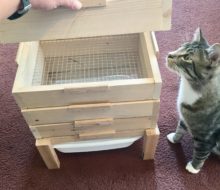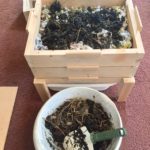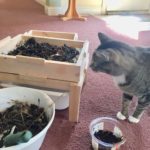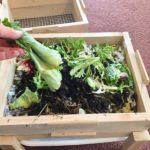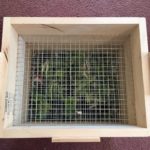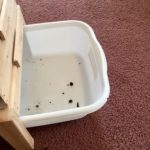Our new vermiculture composting system, also know as a worm box, is small enough to use indoors or on a patio and was made locally by a wonderful gentleman named Jonathan Weir who was kind enough to discount and deliver the amazing system to Sanctuary One. We plan to use this tool to teach school groups and visitors how easy it is to practice vermiculture at home or in the classroom to reduce waste and create nutrient rich fertilizer for gardens and potted plants!
You’ll need:
- 1 vermiculture system or box. Contact wormcomposter101@gmail.com to order a box like ours locally or you can make one with plastic totes — see this link to learn how: https://www.epa.gov/recycle/how-create-and-maintain-indoor-worm-composting-bin)
- Shredded paper, newspaper or phone book pages
- Water
- Dirt from your yard
- Red wiggler composting worms (you can purchase these at your local hardware and garden store)
- Kitchen scraps: Greens, fruits, veggies, coffee grounds and filters, egg shells (rinsed and crushed), tea bags (remove staple). Do not add: Meat, dairy, citrus fruit or rinds, bread, sugars or fatty oils.
Our vermiculture system is small enough to fit in your kitchen, classroom or patio. It’s made up of four stacking trays, each lined with a metal screen.
Wet your paper scraps enough to moisten them but not enough to leave puddles. You can gentle squeeze the paper to remove excess water.
Fill one tray with the damp shredded paper.
Collect some dirt from your yard or garden and slightly moisten it with water.
Add a thin layer of damp soil on top of the wet shredded paper.
Now you’re ready to add your Red Wiggler composting worms to the tray.
Move your worms to the bottom most position of your worm composting structure.
Add fresh kitchen scraps to feed your worms. Do not add meat or dairy to your worm box. Paper towels are okay.
Stack the empty trays on top and cover.
After about a week, or when your paper and kitchen scraps are completely broken down, you’ll add the same mixture of wet paper and kitchen scraps to the tray above your worms and in a day or two they will migrate upward to their newly added food and leave behind a magical mixture of worm compost. You can empty the material onto a tarp (in shady area because the worms are light sensitive) to remove eggs and worms who didn’t find their way up to the next layer. The eggs are about the size of a blackberry seed and range in color from light green to brown. You can add the eggs into the layer where worms are currently residing or to your garden–either way they will continue to multiply. As the worms work their way up through the system, move empty trays from the bottom of the stack to the top.
Some worm castings, eggs and nutrient rich material (the liquid is called worm compost tea) will fall into the tub under the composting system where it can be collected and used to fertilize your garden and potted plants!
Feed your worms each week to continue the process and enjoy the power of nature’s little soldiers!
*Rio the cat is looking for his forever home! You can learn more about this very special boy and all of the Sanctuary One cats at https://sanctuaryone.org/rescue-animals/adopt-us/cats/
Here are a few more quick tips to vermiculture:
- Worms live best in temperatures of 40-80 degrees Fahrenheit. You can bring your worm box indoors in the winter and place it in a shady spot during the summer.
- Red wigglers can double their population in ninety days! It’s best to start with fewer worms than you’ll need. If you have too many worms in your box, you can remove some and add them to your garden, share them with neighbors or your community garden.
- Smell something funny? If your bin starts to smell bed, it may have become aerobic. Carefully lift the bedding from the bottom of the screen where our worms are currently residing, being careful not to disturb them too much, to aerate the material. This will help the worms to have easier access to break down food scraps that have sat for too long.

